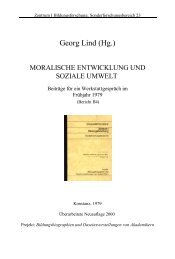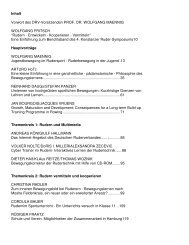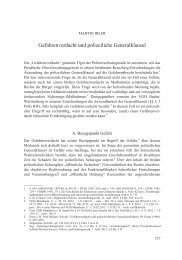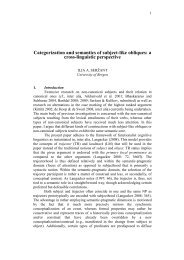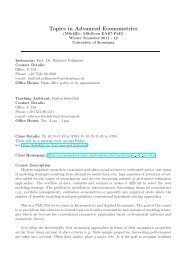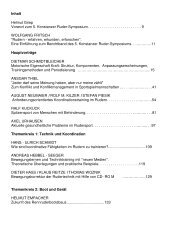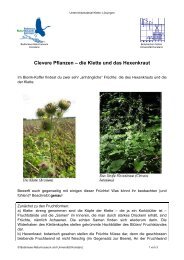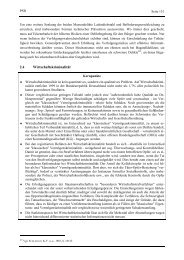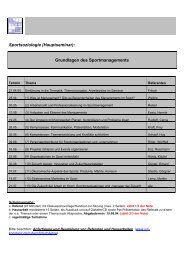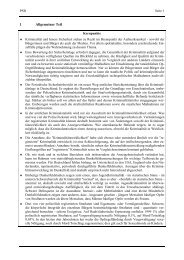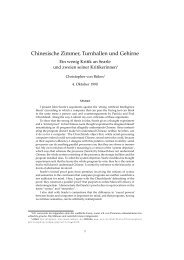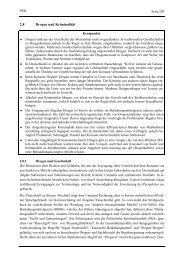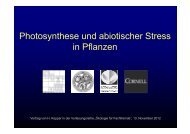Book of Abstracts Book of Abstracts - Universität Konstanz
Book of Abstracts Book of Abstracts - Universität Konstanz
Book of Abstracts Book of Abstracts - Universität Konstanz
You also want an ePaper? Increase the reach of your titles
YUMPU automatically turns print PDFs into web optimized ePapers that Google loves.
A - 34<br />
152<br />
Supported Gold Clusters and Cluster-Based Nanoparticles:<br />
Characterization, Stability and Growth Studies by In Situ Grazing<br />
Incidence Small Angle X-ray Scattering Technique<br />
Stefan Vajda 1 , Jeffrey W. Elam 2 , Byeongdu Lee 3 , Michael J. Pellin 4 , Sönke Seifert 3 , George Y.<br />
Tikhonov 1 and Nancy A. Tomczyk 1 , Randall E. Winans 1,3<br />
1 Chemistry Division, 2 Energy Systems Division, 3 Experimental Facility Division, and 4 Materials Science<br />
Division<br />
Argonne National Laboratory, 9700 South Cass Avenue, Argonne, Illinois 6043, USA<br />
Supported clusters possess unique, strongly size-dependent properties. However, the<br />
Achilles heal <strong>of</strong> supported particles remains their sintering at elevated temperatures or when<br />
exposed to mixtures <strong>of</strong> reactive gases. In this paper, the issue <strong>of</strong> thermal stability and<br />
agglomeration <strong>of</strong> atomic gold clusters and nanoparticles produced by cluster deposition on<br />
oxide surfaces is addressed as a function <strong>of</strong> deposited cluster size, level <strong>of</strong> surface coverage,<br />
temperature and time <strong>of</strong> heat treatment by synchrotron X-ray radiation at the Advanced Photon<br />
Source.<br />
The continuous beam <strong>of</strong> gold clusters was generated in a laser vaporization source. The Aun +<br />
clusters were deflected into setup with an incorporated mass spectrometer for the pre-selection<br />
<strong>of</strong> narrow cluster distributions in the size range Aun + , n=2,…10, with 1 to 5 dominant sizes. As<br />
support, silica as well as Al2O3 and TiO2 films grown by atomic layer deposition on<br />
SiO2/Si(111) were used. Coverages up to 45% <strong>of</strong> atomic monolayer equivalents were employed.<br />
The temperature region <strong>of</strong> aggregation was determined by gradually heating up the samples and<br />
recording 2-D X-ray scattering images during the heat treatment. The analysis <strong>of</strong> the data<br />
provides information about the average size and shape <strong>of</strong> supported particles [1].<br />
The size <strong>of</strong> the nanoparticles formed on the surface upon cluster deposition and their thermal<br />
stability exhibited a very strong dependence on the initial size <strong>of</strong> the clusters, level <strong>of</strong> surface<br />
coverage and material <strong>of</strong> the support. When applying surface coverages higher than 5% ML,<br />
aggregation <strong>of</strong> the clusters into nanometer-size particles with narrow size distribution prevailed.<br />
With decreasing coverage, the fraction <strong>of</strong> not-aggregated clusters significantly increased. Heat<br />
treatment led to final particle sizes determined by initial cluster size, coverage and length <strong>of</strong><br />
treatment. The most striking results were observed when depositing 2.5 % ML <strong>of</strong> Au7-Au10<br />
clusters on SiO2/Si(111): particles <strong>of</strong> one size, corresponding to Au20 were formed. Moreover,<br />
these particles exhibited extraordinary and unexpected thermal stability as well, not undergoing<br />
aggregation until 400 °C, when an onset <strong>of</strong> a slow agglomeration takes place [2]. Work on<br />
supported clusters <strong>of</strong> single size and in reactive gas atmosphere is currently under progress.<br />
This work and use <strong>of</strong> APS was supported by the U.S. Department <strong>of</strong> Energy, Office <strong>of</strong> Basic<br />
Energy Sciences, Division <strong>of</strong> Chemical Sciences, Geosciences, and Biosciences under contract<br />
number W-31-109-ENG-38.<br />
References<br />
[1] R. E. Winans, S. Vajda, B. Lee, S. J. Riley, S. Seifert, G.Y. Tikhonov, N. Tomczyk, J. Phys.<br />
Chem. B, 108, 18105 (2004).<br />
[2] S. Vajda, R. E. Winans, J.W. Elam, B. Lee, M.J. Pellin, S.J. Riley, S. Seifert, G.Y. Tikhonov and<br />
N. A. Tomczyk, invited paper, submitted to ACS.



